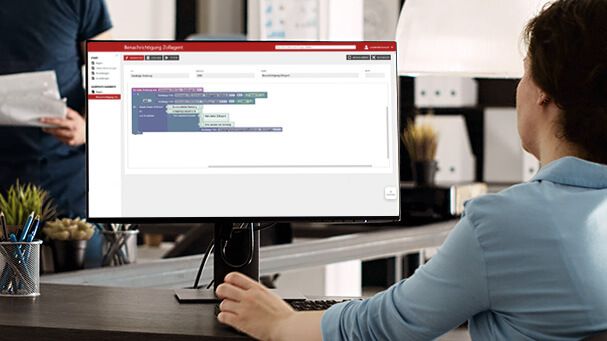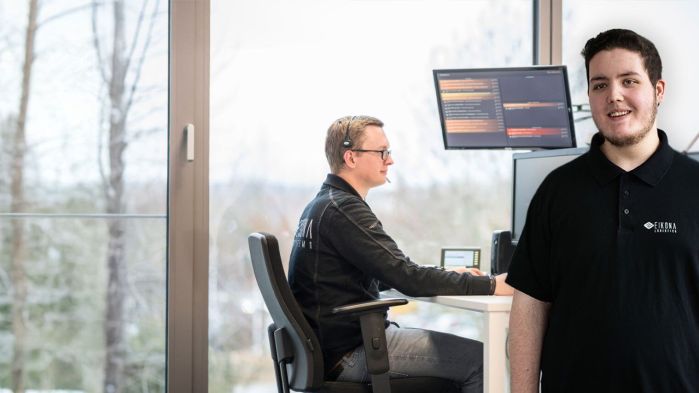Network topics are his absolute passion – you quickly notice that when you talk to Michael Weinbeer about his job. In November 2013, he began his training as an IT specialist for system administration at EIKONA Logistics, which he completed with flying colours just under three years later. While services such as setting up workstations and on-site customer support were initially on the agenda, the number of customer enquiries regarding WiFi equipment in logistics halls increased over time. So, working on WiFi projects became Michael Weinbeer’s daily business. Since then, he has been the number one contact person at EIKONA Logistics when it comes to network technology and WiFi issues.
Since projects are the everyday business of a network administrator, a typical day can hardly be described – sometimes the agenda is dominated by field work at the customer’s site, sometimes there is more office work. Generally speaking, it can be said: Michael Weinbeer spends time in the office preparing and documenting projects. In online-meetings, he talks with customers to discuss their wishes and requirements for the industrial WiFi, consults with other project participants such as the electricians, orders the necessary hardware or preconfigures the network components.
He spends most of his time on site at the customer’s premises when it comes to the on-site inspection, installation of network components, illumination, check-ups and so on. He does not travel alone: whenever possible, he is accompanied by trainees so that they gain as much practical experience as possible. The master electrician is also part of the team and takes care of the necessary cabling.
If there is a longer lead time for a project, Michael Weinbeer also assists the support team, where the other system administrators ensure that the customer systems run as desired. Third-level support and IT services converge there.
Requests for the installation of network technology come to the network administrators in various ways. Sometimes it is about follow-up projects with customers for whom they have already installed the network technology, sometimes it is about recommendations. Customers also come to EIKONA Logistics via internet enquiries or recommendations from product partners, such as LANCOM.
The planning of an industrial WiFi takes place either remotely or on site – depending on whether the EIKONA Logistics team already knows the customer and the conditions on site or not. In an initial needs analysis, it is clarified which requirements the customer has for his network. What is needed, which strains does the network have to withstand? What is perhaps currently missing and should be upgraded?
This is followed by the planning of the WiFi measurement with the help of computer programmes that simulate how strong the WiFi signal will be everywhere in the hall and on the outdoor area. Building plans, which contain information on ceiling height, wall thickness, etc., are used as a basis. Once the necessary hardware has been ordered, the EIKONA Logistics team pre-configures the network components in the office so that the network technology can be installed at the customer’s premises as quickly as possible. Assembly, commissioning, and tests then take place on site, but due to the careful preparations, this time can be reduced to a minimum.
Remote analyses as well as network maintenance are also carried out from the office. After a test phase in which the customers check whether they can cope with the installed network technology and the quality of the WiFi signal, the network parameters are checked. The actual values are compared with the planned values so that, if necessary, adjustments can be made.
It is important for Michael Weinbeer’s team to always have their finger on the pulse of the times and to think in a future-oriented way so that the customer’s network technology is state of the art. With the constant development of the technology, follow-up projects always arise in which the customer’s network can be further improved thanks to technical developments.
Logistics buildings present special challenges when it comes to WiFi. Normally, the ceiling of a room is well suited for the installation of access points – but in logistics halls, the ceiling height can amount to up to 12 metres or more, so that a normal signal would not reach the floor. The goods being stored in the hall can also pose a problem for the signal. For example, if block storage is planned, boxes of paper towels may be stored on wooden pallets one day, but metal mesh boxes may take their place the following day, which sensitively interfere with the signal. Another challenge is the fact that material handling vehicles move faster than a person on foot – the signal must be able to keep up so that the staff notice the connection changes from radio cell to radio cell as little as possible (roaming).
All this has to be taken into account in the planning. The motto is: It is always possible to reduce the number of access points later, but it is difficult to increase their performance. therefore, the access points are generously calculated and optimally matched to each other so that uninterrupted roaming can be guaranteed and unforeseen disruptions such as walls that are thicker than planned or signal-interfering materials in the warehouse are not a problem.
The network solutions from LANCOM Systems are perfectly suited for the harsh environments that naturally occur in logistics due to dust, changing temperatures, and so on. When it comes to access points, the LANCOM OW-602 is the most reliable solution – not only indoors.
A strong WiFi signal can also be important outdoors, for example when a digital yard control system is in use – then, data must also be transmitted in real time outdoors. For this purpose, access points with omnidirectional antennas are installed on the entire outside surface of the hall so that the signal reaches everywhere in the yard. If a location is somewhat further away, such as a gatehouse, then a radio link can also be set up – this way, no cable has to be laid, but two antennas are linked together via a point-to-point connection. Devices that have at least an IP67 rating are used here so that they can withstand the harsh environments of the outdoor area.



